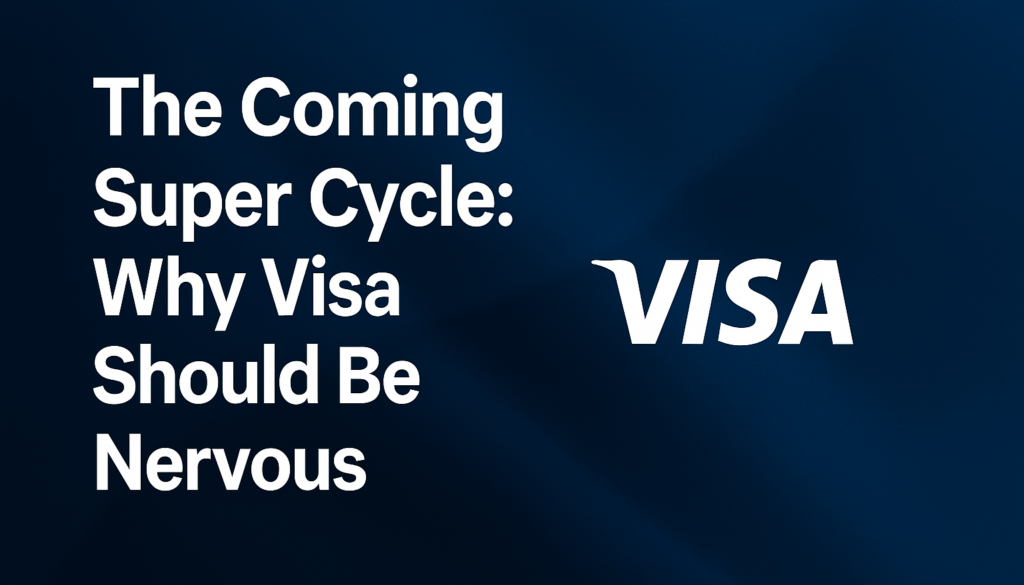The Coming Crypto Super Cycle: Why Visa and other Payment Processors Should Be Nervous
We’re standing at the edge of a new financial super cycle. But this one isn’t about bull markets or meme stocks. It’s about a tectonic shift in how money moves, how payments are processed, and how value flows across the globe. It’s the collision of deregulation, economic uncertainty, and unstoppable innovation—and it’s about to refactor the entire payments industry.
Visa, Mastercard, and the old guard of finance? They’re standing on rails built for an analog world. Meanwhile, a new wave of infrastructure is being laid—fast, composable, and on-chain.
Let’s break it down.
1. Deregulation by Default
Trust in centralized financial institutions is eroding. Governments and regulators can’t keep up with the pace of fintech, crypto, and borderless digital payments. This isn’t regulatory clarity; it’s regulatory fatigue.
And where regulation lags, innovation surges.
2. Global Chaos Drives Decentralization
Inflation, geopolitical instability, and banking failures are pushing both consumers and enterprises to look for alternatives to legacy rails.
We’re witnessing a growing demand for permissionless, borderless value transfer.
3. Crypto Hit Critical Mass
2017 was the ICO era. 2021 added DeFi and NFTs. But in 2025, we’re entering a phase of usable, scalable, and seamless financial products:
- Real-time settlement
- Built-in compliance
- Open, composable tech
The best part? It works without the Visa tax.
4. The Visa Model Is Broken
Visa and Mastercard built empires around physical-world assumptions:
- Swipe fees (2-3%)
- Slow settlement times
- Intermediary-heavy architectures
These models crumble in a digital-first, real-time economy. The next stack demands better.
5. Enter On-Chain Money Movement
Blockchains like Solana are proving the rails can scale:
- Sub-cent transaction fees
- Settlement + clearing + execution in one layer
- Global reach without FX middlemen
Combine that with smart contract logic, and you’re looking at the future of finance.
6. The Builders Are Already Here
The next generation of fintech isn’t coming. It’s already here:
- Wallets that act like banks
- Pay-to-username, not pay-to-card
- USDC instead of ACH
- On-chain payroll
- Automated cross-border commerce
And your customers won’t even know it’s crypto under the hood.
7. Stripe, Shopify, and the New Custodians of the Future
The biggest winners in the stablecoin era might not be new players—they might be the modern fintech giants already embedded in daily business transactions.
Stripe could become the go-to abstraction layer for accepting stablecoin payments, handling on-chain to off-chain conversions, automating compliance, and delivering payouts instantly in USDC or similar assets.
Shopify has the opportunity to turn every merchant into a Web3-native business without them needing to know it. By integrating wallets and stablecoin checkout flows, Shopify could reduce processing costs and expand into global markets with minimal friction.
These companies understand custody, compliance, and UX. They don’t need to reinvent the wheel—they just need to embrace programmable money.
Expect Stripe to become the “AWS for stablecoin payments,” and Shopify to become the “interface for Web3 commerce.”
Custody, fiat on-ramps, and treasury tools will be the battleground for these giants.
Stablecoin Ecosystem Cheat Sheet: Where the Money Flows
Here’s how stablecoin infrastructure is already disrupting payment value chains:
Stablecoin Issuer (e.g., Circle, Tether)
- Reserves Revenue: Yield on U.S. Treasuries backing stablecoins
- Mint/Burn Fees: Fees for creating or redeeming tokens
Centralized Exchange (CEX)
- Trading & Spread Fees
- Withdrawal & Priority Fees
- Stablecoin lending and cross-border flows
Decentralized Exchange (DEX)
- Swap Fees: 0.01%-0.3% per transaction
- LP revenue and protocol incentives
Wallet Providers (e.g., Phantom, MetaMask)
- Built-in swap fees
- Gas abstraction and referral revenues
Smart Contracts / Protocols
- Gas and priority fees
- Arbitrage bots and MEV extraction
Networks (Solana, Ethereum, Avalanche)
- Micro-fees per transaction
- Validator tips and block rewards
Lending Platforms (Aave, Compound)
- Interest spreads
- Flash loan and yield farming income
Institutional Arbitrage
- Mint/redeem cycles
- Regional exchange arbitrage
Bridges & Wrapped Tokens
- Bridge fees and wrapped asset value capture
USDC & USDT
- T-bill yield
- Redemption fees
- Multi-chain dominance
Solana
- $0.00025/tx costs
- Ideal for retail and micro-payments
- Built-in scale, real-world adoption already in motion
TL;DR
We’re entering a Super Cycle:
- Regulatory fatigue
- Macro chaos
- Innovation at scale
- Founders building the new rails
And the old system? It’s running out of time.
Visa doesn’t need to get disrupted tomorrow. It just needs to get out-competed one transaction at a time.



